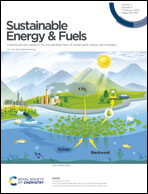Design and synthesis of multifaceted dicyanomethylene rhodanine linked thiophene: a SnOx–perovskite dual interface modifier facilitating enhanced device performance through improved Fermi level alignment, defect passivation and reduced energy loss†
Abstract
In perovskite solar cells (PSCs) the defect density at the charge selective layer (CSL)/perovskite absorber interface is always a few orders higher than that of the perovskite bulk due to the existence of inevitable dangling bonds and not so ideal perovskite absorber film formation on the CSL. In this work, defects at the interface of the tin oxide (SnOx) electron selective layer (ESL) and cesium-formamidinium lead iodide (CsFAPbI3) perovskite absorber were passivated simultaneously by a holistically designed and synthesised small molecule (AA6), which possesses vinyl spacer units that are conjugated to electron-rich thiophene on either side and tethered with electron-withdrawing dicyanomethylene rhodanine units. By passivating the oxygen-vacancy defects of SnOx and concurrently passivating the undercoordinated ionic defects of the perovskite absorber, the interfacial nonradiative recombination was suppressed significantly. AA6 interface passivation also improves the energy level alignment by causing an upshift of the Fermi level of SnOx from 5.05 eV to 4.85 eV which led to the reduction of the energetic barrier (250 meV to 50 meV) assisting in improved charge extraction from the perovskite absorber to SnOx. This correlates well with improved photoluminescence quenching efficiency (PLQE), reduced photoluminescence lifetime and improved thin film conductivity. Further, the increase in contact angle during AA6 passivation results in the improvement of perovskite grain size which led to the reduction of defect density per unit area, which matches well with the lower defect density obtained from space charge limited current (SCLC) measurements. One order lower leakage current (dark J–V analysis) was seen after interface modification, implying a better junction formation at the SnOx/CsFAPbI3 interface. With all these sought-after features, the optimised unencapsulated device achieved a power conversion efficiency (PCE) of 16.14% with an open circuit voltage of 1.05 V when measured under high relative humidity (RH ∼65–70%) conditions whereas the PCE and open circuit voltage of the pristine device were 13.96% and 1.0 V respectively. This work demonstrates that the prudently designed organic small molecule (AA6) reduces the recombination and defect induced charge carrier trapping at the CSL/perovskite interface which results in more efficient charge carrier extraction, lower energy loss and an improved device performance.



 Please wait while we load your content...
Please wait while we load your content...